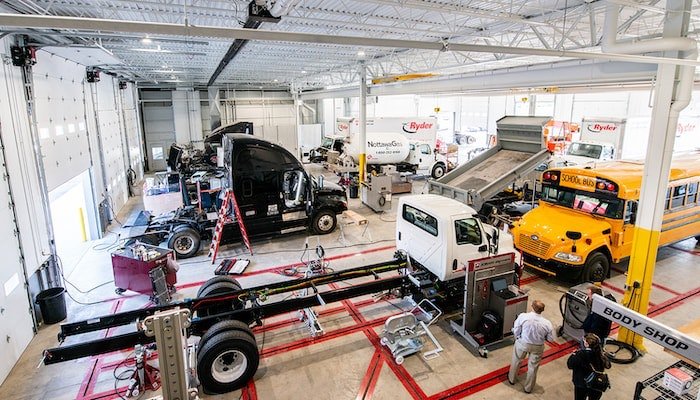Truck repair shop owners face unique challenges. You might deal with unexpected repairs or need specialized skills among your technicians. These challenges can make it tough to stay organized and profitable. That is where truck repair shop management comes in. Let’s look into five essential tips that you can get help with.
Implement an Efficient Scheduling System
A well-organized schedule is the backbone of a successful truck repair shop. Effective scheduling through truck body repair shop management software can:
- Reduces downtime
- Enhances customer satisfaction
When your shop is efficient, customers are more likely to return for future services.
Why Scheduling Matters
Your technicians can maximize their time and skills when you have a clear schedule. This means:
- Fewer delays
- Quicker turnaround times for repairs
Happy customers are likelier to recommend your shop, leading to increased profits.
Best Practices for Balancing Workload
To make the most of your scheduling system, here are some best practices:
Plan Ahead
Look at historical data to predict busy times and schedule staff accordingly.
Communicate
Regularly check in with your technicians about their workloads and preferences. This helps avoid burnout and ensures everyone is on the same team.
Stay Flexible
Be prepared to adjust your schedule as needed. Unexpected repairs or changes in customer demand can happen. However, being adaptable will help you manage these challenges smoothly.
Invest in Quality Inventory Management
Effective inventory management is crucial for running a successful truck repair shop. When your inventory is well-organized, it helps to:
- Prevent delays
- Controls your costs
Imagine a customer coming in for a quick repair only to discover that you’re out of the necessary parts. This not only frustrates the customer but can also hurt your business reputation.
Why Inventory Management Matters
Good inventory management ensures you have the right parts on hand when needed. This minimizes downtime for your technicians and keeps your customers happy.
Additionally, by managing your inventory effectively, you can:
- Avoid overstocking or understocking
- Save money
- Improve cash flow
Techniques for Effective Inventory Control
Here are some practical techniques to help you maintain effective inventory control:
Barcode Systems
Implementing a barcode system can make tracking parts much easier. Scanning items in and out gives you real-time visibility of your inventory levels.
Regular Audits
Conduct regular inventory audits to check for discrepancies. This ensures your records match your physical inventory.
Reorder Triggers
Set up reorder triggers for essential parts. When your stock dips below a certain level, the system can automatically alert you to reorder.
Focus on Customer Relationship Management (CRM)
Building strong customer relationships is vital for the success of your shop. Customers who feel valued and understood will return and recommend your services. This boosts your repeat business and helps you grow through positive word-of-mouth.
Importance of Building Customer Relationships
Strong relationships with your customers lead to loyalty. Satisfied customers are your best marketers. They’ll share their experiences with friends and family, bringing in new business. The best thing is that you do not have to spend on advertising.
Features of an Effective CRM System
An effective CRM system is crucial for managing customer relationships. Here are some key features to look for:
Tracking Customer History
A good CRM lets you keep detailed records of customers’ past services and preferences. This information helps you provide personalized service that meets their specific needs.
Follow-Ups
Automating follow-up reminders can help you check in with customers after their service. It would help to ask for feedback or remind them of upcoming maintenance. This shows that you care and keep your shop top-of-mind.
Feedback Management
An effective CRM should help you collect and analyze customer feedback. Understanding what your customers like or dislike can help you enhance their experience.
Tips for Personalizing Customer Interactions
Consider these tips for personalizing customer interactions:
Use Customer Data Wisely
Analyze the data you collect to understand trends and preferences. This allows you to tailor your services and communications to individual customer needs.
Send Personalized Communications
Use names in your emails and recommend services based on past purchases. Small gestures can make a big impact.
Ask for Input
Encourage customers to share their thoughts on services or ask what they want to see in the future. This makes them feel valued and helps you improve your offerings.
Embrace Truck Repair Shop Management Tool
Embracing technology and automation can significantly streamline your operations. Reducing manual tasks through the best truck repair shop management software can:
- Save time
- Cut costs
- Provide a better customer experience
How Technology Can Streamline Operations
Integrating technology into your shop can cut manual processes. Automation can handle:
- Scheduling
- Invoicing
- Inventory management
It also frees your staff to focus on more critical tasks, like:
- Repairing trucks
- Assisting customers
The result? A more efficient shop that keeps your technicians productive and your customers satisfied.
Examples of Useful Technologies
Here is how management software for truck repair shops can transform your operations:
Diagnostic Tools
Modern diagnostic tools can quickly identify vehicle issues. It allows your technicians to work more efficiently. These tools help reduce troubleshooting time so repairs can be completed faster.
Automated Invoicing
Implementing automated invoicing systems can streamline billing processes. With automated invoices, you can:
- Reduce errors
- Speed up payments
- Keep financial records organized without manual input
Reporting Systems
Reporting software lets you track key performance indicators (KPIs) like:
- Sales
- Customer satisfaction
- Technician efficiency
This data can help you make informed decisions to improve your shop’s performance.
Adoption Strategies
Integrating new technologies can be manageable. Here are some tips to ensure a smooth transition:
Provide Comprehensive Training
Ensure your staff understands how to use new tools. Offer hands-on training sessions so everyone feels comfortable with the technology.
Start Small
Introduce new technologies gradually. This allows your team to adapt without feeling overwhelmed. Begin with one system—like automated invoicing—before adding more complex tools.
Gather Feedback
After implementing new technologies, ask your team for feedback. Understanding their experiences can help you:
- Identify challenges
- Improve the process for future tech adoptions
Regular Training and Development for Staff
Investing in ongoing training and development for your staff is essential. Regular training keeps your team’s skills up to date. Staying informed about the latest techniques and technologies can make all the difference.
Why Ongoing Training is Crucial
Things can change rapidly in the truck repair business. By providing continuous training, you ensure that your staff remains knowledgeable and skilled. This enhances:
- Quality of service your customers receive
- Boosts employee confidence and job satisfaction
- Reduces turnover
- Fosters a positive work environment
Types of Training Programs to Consider
When planning your training programs, consider focusing on these key areas:
Technical Skills
Regular workshops can help your technicians stay ahead of the curve on:
- Latest diagnostic tools
- Repair techniques
- Maintenance practices
This ensures they can handle the newest technologies that come through your doors.
Customer Service
Training your staff on customer interaction skills can enhance the experience for clients. This includes effective communication, problem-solving, and handling difficult situations with professionalism and empathy.
Safety Protocols
Ensuring that your team is up to date on safety practices is vital. Regular safety training helps prevent accidents and injuries and keep your staff safe.
Resources for Training
There are plenty of resources available to help you implement training programs effectively:
Workshops
Consider organizing in-house workshops or partnering with local training providers. Hands-on training can improve technical skills, allowing your staff to practice.
Industry Conferences
Attending industry conferences can provide valuable insights into the latest trends and technologies. These events also offer networking opportunities in the field.
Conclusion
Effective management is key to your shop’s success in truck repair. You can meet customer needs. Moreover, truck repair shop management helps you thrive in a competitive market. Remember, each element works together to enhance service quality and boost customer satisfaction. So, take the time to refine your processes and invest in your shop’s future.




